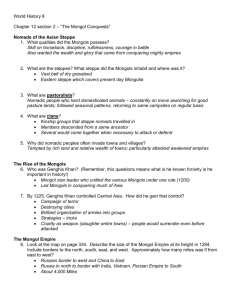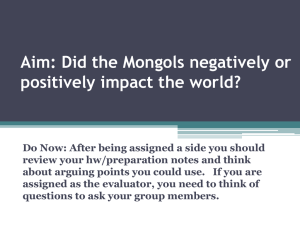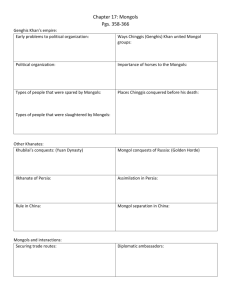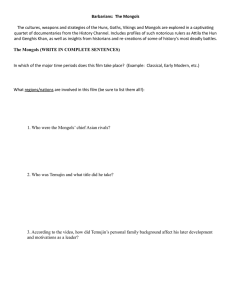Bellringer: 3/3 and 3/4 • 2. Make the following ToC updates:
advertisement
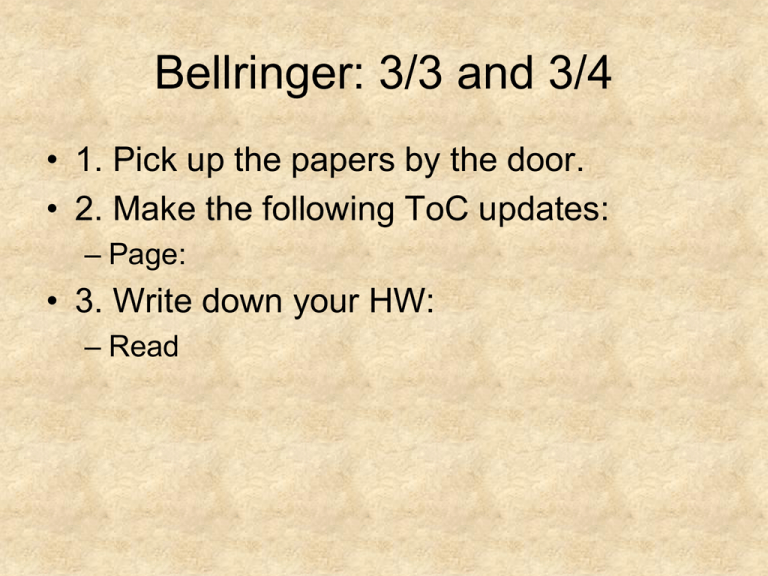
Bellringer: 3/3 and 3/4 • 1. Pick up the papers by the door. • 2. Make the following ToC updates: – Page: • 3. Write down your HW: – Read 1. BACKGROUND ON THE MONGOLS Background on the Mongols: • Declared themselves descendants of Huns who founded the 1st steppe empire in late Classical era. • Said to be called “Tartars” especially by Westerners (“people from hell”), though a misnomer: The Mongols actually conquered a tribe called the Tartars Background on the Mongols: • Nomads • Need for water leads to conquest - Central Asia lacked rain for agriculture – Reasons why they move westward towards Europe • Greatest Opportunity was trade – horses! 2. IMPORTANT LEADERS OF THE MONGOLS: Genghis Khan • Valued individual merit & loyalty • Fighting wasn’t honorable; winning was. So, used any means necessary to win (trickery, etc.) • Conscripted peasants – Had a negative opinion of peasants – Yaks = peasants • Refugees would flee to the cities in fear, but the cities were conquered, too • LOVED negative PR – Allowed & encouraged true or false stories to be circulated in order instill fear. • Fought on the move: didn’t care if chased or fled (unlike sedentary soldierfarmer), just wanted to kill the enemy. • In 25 years, subjugated more land & people than the Romans did in 400 years. Genghis Khan (innovations) • Relied on speed & surprise • Perfected siege warfare (not relied on defensive fortifications) • Allocated fallen soldiers’ share of loot to widow/children (ensured support) • Reorganized army so each unit had a mix of tribal/ethnic peoples and they had to live & fight together – GOAL: transcend kinship, ethnicity, & religion. • Religious tolerance • Instituted postal system for communication • Ordered writing system created • Abolished torture & insisted on rule of law (to which even the khan was accountable) 3. TACTICS AND STRATEGIES OF MONGOL WARFARE Strong Equestrians and Archers • The Mongols were oriented around extreme mobility. They carried their houses with them, drank their own horse's blood to stay alive, and could travel up to 62 miles per day. • They had an elaborate prioritymail-system which allowed orders to be transmitted rapidly across Eurasia. • Mongol archers were deadly and accurate – Their arrows could kill enemies at 200 meters (656 feet) Mongol War Equipment • The warrior carried a protective shield made of light leather armor – which was laced with a lacquerlike substance in order to make it more impervious to penetration by arrows, swords and knives, and also to protect it against humid weather • The Mongol warrior used to wear Chinese silk underwear, if it could be obtained, because it was a very tough substance – If arrows are shot from a long distance, it would not penetrate the silk – It would also prevent poison from entering the bloodstream • • • During winter they wore several layers of wool as well as heavy leather boots with felt socks on their feet. The legs were often protected by overlapping iron plates resembling fish scales, which were sewn into the boots. Each warrior carried a battle axe, a curved sword known as scimitar; a lance, and two versions of their most famous weapon: the Mongol re-curved bow. – One of the bows was light and could be fired rapidly from horseback, the other one was heavier and designed for longrange use from a ground position Psychological Warfare • Genghis Khan combined fake retreats with accurate archers to pick off his European enemies. • Genghis Khan slaughtered a few cities, in an attempt to scare all other cities to surrender without a fight. He, being a practical leader, also valued smarts more than bravery – If enemies surrendered without resistance, the Mongols usually spared their lives, and they provided generous treatment for artisans, craft workers, and those with military skills – In the event of resistance, the Mongols ruthlessly slaughtered whole populations, sparing only a few, whom they sometimes drove ahead of their armies as human shields during future conflicts 4. THE MONGOL EMPIRE What do the Mongols conquer? • SHORT ANSWER: EVERYTHING • 1206-1227 Reign of Genghis Khan • 1211-1234 Conquest of northern China (Kublai Khan) • 1219-1221 Conquest of Persia • 1237-1241 Conquest of Russia • 1258 Capture of Baghdad • 1264-1279 Conquest of southern China How did the Mongols conquer so much territory? Ruthless annihilation of resistance (terror tactics). General benevolence when no resistance. Cities generally left under native governors. Religious tolerance important in consolidating rule, gain support of minorities oppressed by Muslims. • Administration commonly more benign, less corrupt than pre-Mongol government. 1. War with Persia 1218-1222 War started after Persians put Mongol emissaries to death. War of annihilation on both sides. Mongol detachment sent to pursue Shah across his own empire. Following conquest of Persia, Mongol troop circled Caspian. Results in Mongol victory (of course) 2. Mongols vs. Islam End of Abbasid caliphate control and world dominance. Eventually sack Baghdad, the heart of Islamic society/culture Opened path for political division within Islam between the Ottomans and the Mamluks. 3. Invasions of Eastern Europe 3. The Mongol Drive to the West - Russia and Europe conquered by Mongols - Russia now called the Golden Horde, which drove westward . - Kiev was in decline by the 13th century, and Russia was unable to unite before the Mongols (called Tatars by Russians) - Genghis Khan’s grandson, Batu, defeated the Russian armies one by one, resisting armies were razed - Kiev (Russia) was taken by 1240 …very few towns survived (only Novgorod and Moscow because they submitted) 4. Mongols in Russia - The Russians became vassals of the khan of the Golden Horde, a domination which lasted for 250 years - Russian peasants had to meet demands from their own princes AND the Mongols, and many sought protection by becoming serfs, changing the Russian social structure until the 19th century - Some cities like Moscow benefited from Mongol rule by increased trade, but when the Golden Horde’s power weakened, it led the resistance - Although Mongols remained active in the region through much of the 15th century, Moscow became the center of political power in Russia - The Mongols influenced Russian military and political organization, but most significantly isolated them from developments in Western Europe did not experience the Renaissance or Reformation Russia under the “Golden Horde” • Destroyed most cities & demanded high tribute. • However, the Mongols left Russia largely alone & few Mongol officials were there (INDIRECT rule). – Russia had lots of independent principalities, each required to send tribute …or else. • Moscow (Muscovy) benefits from Mongol presence – Grows due to postal system, financial structures, & census. Moscow became a cultural & economic center. • Armenians, Georgians, & Russians thought Mongols were a punishment from God who “fetched the Tartars against us for our sins.” • Limited Russia’s interaction with Western Europe (e.g. Russia was isolated from the cultural effects of the Renaissance) --a period of cultural decay except in northern Russia. • Lasted the longest of the all the khanates (until 1480) Mongols in Russia Good: •Centralization politically •Protected Russia from attacks (Teutonic Knights) Bad: •Russia cut off from political, economic, and intellectual development 5. Mongols in Europe • Mongols defeated Germans, Poles, Bulgars, & Hungarians (whose land was most desired because of grassy plains). • Eastern Europe was poor compared to Chinese & Muslim areas, so the Mongols turned away from several areas leaving Europe to suffer the least from the Mongol attacks • Europe gained SO much from the advantages of the contact through merchants & exchange of diplomatic & religious envoys. More Effects on Europe • Disappointed with loot from European invasions, Mongols allowed Italian merchants in Crimea to take many of their European prisoners to sell as slaves (esp. to Egypt) in exchange for large amounts of trade goods. • This began a long & profitable relationship between Mongols & merchants of Venice & Genoa who set up trading posts in Black Sea: Italians supplied Mongols with manufactured goods in return for the right to sell the Slavs as slaves in the Mediterranean market …slaves who would ultimately defeat the Mongols as the Mamluks in Egypt. • Silk routes opened … & then spread PLAGUE to Europe. 6. Mongols in China Mongols in China: • Start the Yuan Dynasty under Kublai Khan • A new social structure emerged: – 1. Mongols at the top – 2. Nomadic and Islamic allies – 3. Ethnic Chinese 5. IMPACT OF THE MONGOLS Impact of the Mongols – Military: • New methods of warfare • New technologies (arrow styles, armor, etc.) – Introduced new military techniques & organization to Turks & Europeans – such as small organized units, the use of cavalry & the effective use of gunpowder • Military was massive, helped to create large empire The Impact of the Mongols: POLITICAL • Mongol conquest left Russia more divided culturally & less developed than Western Europe • Descendants of Genghis Khan & Timur established the Mughal Empire in India • Mongol defeat of the Seljuk Turks in 1243 CE allowed for the later rise of the Ottoman Turks in the Middle East The Impact of the Mongols: SOCIAL • Mongols practiced religious toleration in the Middle East & Europe • Often converted to local religions – Allowed Islam & Orthodox Christianity to continue to thrive • Russia became isolated from European trends like the Renaissance • Practiced Orthodoxy – Continued the split between Eastern & Western Europe started w/ the Byzantine Empire • The Black Plague devastated Europe in the 14th C • Mongol expansion & control of the Silk Road allowed for cultural diffusion & exploration on an unprecedented scale – including the journey of Marco Polo The Impact of the Mongols: ECONOMICS • Global trade expanded dramatically under Mongol control – EX: Italians were the primary beneficiaries in Europe; security, use of paper currency, control & management of Silk Road all increased trade in the Eastern Hemisphere • Europeans exposed to a much greater number of Chinese goods on a large scale – Gunpowder & printing being among the most influential • The global trade network became more intertwined • Mongol decline made land travel more dangerous & a shift to seafaring occurred in Europe & China after 1400 CE How did Mongol trade and conquest allow for exchange between cultures? • Mongols brought the Muslim and European worlds new military knowledge, especially the use of gunpowder • Trade and cultural contact between different civilizations throughout Eurasia became much easier • Trading empires established in their dominions by Venetians and Genoese provided experiences for later European expansion • An unintended consequence was the transmitting of the fleas carrying the bubonic plague (black death) from China to central Asia to the Middle East to Europe Exchanges During the Mongol Era From Europe From Southwest Asia From South Asia From East Asia Honey Horses Glassware Slaves Textiles Rugs Incense Finished iron products Finished gold products Spices Gems Perfumes Textiles Gunpowder Firearms Rockets Magnetic compass Porcelain Silk Maritime Technology Paper Making Printing Tea Christian missionaries Italian merchants European diplomats Muslim merchants Nestorian merchants Muslim diplomats Indian merchants Indian diplomats Buddhist religious objects Chinese bureaucrats Chinese artists, artisans East Asian diplomats Sugar cane Black Death Intellectual Exchanges of Ideas, Art, Architecture, Knowledge was constant The Mongols The Good, the Bad & the Ugly THE GOOD (accomplishments & contributions) • Military Strategy & Innovation – Cavalry, Horse Archers, surprise attacks, sieges - Genghis first needed to disband tribal loyalties • Religious Tolerance (converted to all faiths in region except Hinduism) • Common Legal Code • Utilized skills of conquered peoples – artisans, soldiers THE GOOD (accomplishments & contributions) Discipline, obedience to own laws Sense of honor and loyalty,(even in one’s enemies) High status of women • TRADE – source of diffusion – goods, ideas & people - under Mongol rule it was less risky Pax Mongolica The Mongol Empire at its height THE BAD – (failures & struggles) • Constant in-fighting for power – “Khan” • Genghis never set up centralized rule, Kublai struggled with it (Yuan Dynasty) • Kublai failed to conquer Vietnam, Burma, Cambodia & Japan • Inability to control China without considerable force • Over-spending Shortly after Chinggis Khan’s death, his empire split into four Khanates THE BAD, cont… • THE PLAGUE!!! • Over-extension – loss of control in Persia – Just like in Rome, Byzantine Empires • nomadic lifestyle vs. need to settle (centralized government) THE UGLY – (What!?! Those Mongols were CRAZY!!) • Surrender or Die • Looting & Destruction of Cities • Massacres (1.6 Million in 1 Afghan city, as many as 18.4 Million total killed) • Use of organized tactical terror • All exemplified by the Ilkhanate’s conquering of Middle East (Persia) THE UGLY, cont… • Lots of Babies - as many as .5% of the Earth’s current male population can trace genetic lineage back to Genghis (500 wives & concubines) • Plague catapults – biological warfare? • Strange diet, hairstyles and odor • Cannibalism? • Genghis’ funeral parade of death? Question: How did the Mongol conquests impact/bring an end to the postclassical civilizations in Eastern Europe, Western Europe, and Islam? 1. Russia 2. Byzantine Empire 3. Western Europe Answer: •Russia – end of Kievan dominance power shifts to Moscow •Byzantium – Ottoman dominance and fall of Constantinople (1453). •Western Europe – limited direct impact but Black Death has later effect. Trade increases with East.



